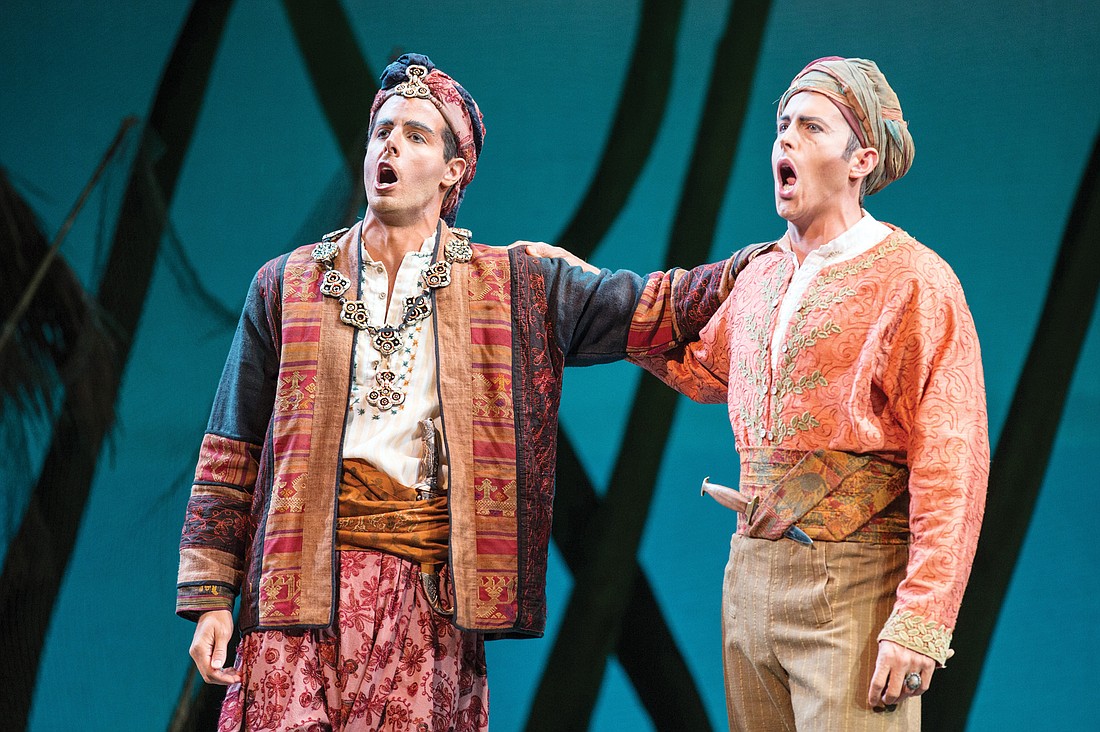- November 27, 2024
-
-
Loading

Loading

”The Pearl Fishers,” written by Bizet when he was almost 25, is the 19th century’s answer to what would become silent movies: not much plot, lots of histrionics and a definite demand on audiences to suspend their disbelief. In a nutshell, it’s the story of two men, Zurga and Nadir, who were best friends as children but who split up because they both fell in love with the same “mysterious” woman. Nadir, a hunter who was formerly a fisherman but left the village, returns and meets Zurga, who has become the chief of the pearl fishers. They pledge an everlasting friendship that will never again allow a woman to come between them.
Leila, that woman, is now a priestess and she, too, has taken a vow to keep her face hidden, sing and pray for the village and never, ever to fall in love with a man. Of course, she fell in love with Nadir some years ago; but she fails to mention that to the High Priest, Nourabad, or to Zurga, who tells her she’ll die a terrible death if she breaks her vows. Not only that, but Leila, as a child, saved Zurga’s life, but she was so young at the time. She doesn’t recognize him and he, of course (hey, this is opera), doesn’t recognize her. Nadir and Leila find each other, can’t resist temptation, are caught and, through a series of implausible but very operatic twists and turns, meet their fate, as does Zurga.
Confused? Confounded? It doesn’t matter because Bizet’s music is so glorious, so ear-catching and opulent, the characters could be reciting the alphabet and we wouldn’t care.
Unfortunately, in the hands of stage director and choreographer Keturah Stickann, in her Sarasota Opera debut, the characters never have a chance to plow whatever depths there may be. She has them sing their loving lines to the audience, only turning to each other when they’ve finished a phrase. She has whatever facial or body emotion they portray played to the wings so we can’t really see it. She has a group of dancers upstaging the chorus. And she has the chorus (and everyone else) so stilted and stylized, the opera might as well be an oratorio. There are also occasional incomprehensible things such as group hugs on both sides of the stage that look like football huddles or the final episode of “The Mary Tyler Moore Show.” In other words, much of the staging was inexplicable and perplexing.
The singers, however, were content to leave their acting to the music and, by doing so, left us, for the most part, musically and vocally satisfied.
Zurga, sung by baritone Lee Poulis, was vocally strong and resilient. His character may change his mind more quickly than a politician running for office but his voice was always there — robust, solid and compelling.
Heath Huberg, who sang Cassio in last season’s “Otello,” has a light, but pleasing, voice that runs into a little trouble when he tries to push it beyond its present capabilities. He and Poulis did an admirable job with the well-known duet, “Au font du temple saint,” but he had vocal problems trying to sing his aria, “Je crois entendre encore,” which calls for great maturity and finesse in the upper, softer portions of the voice.
Asako Tamura, heard here last as Madama Butterfly, has a beautiful, rich voice with point and passion so, although her movements may have been restricted, her singing was not. It soared over the footlights and conveyed the emotion and passion Bizet wrote into his score. Her aria, “Comme autre fois,” (which is so close in style and writing to the one Bizet later gave Micaela in “Carmen” — French horn and all), was quite splendid.
Andrew Gangestad, as Nourabad, the High Priest, was — as always — stalwart and sturdy.
The Sarasota Opera Orchestra is a grand group and played the score musically and beautifully, in spite of the conductor, Robert Tweten — who has some great credits to his name — who led a pallid and colorless reading without the important forward motion and tension inherent in this musically passionate piece. He seemed bent on following his own ploddingly lethargic tempos and, as a result, the whole opera bogged down where it should have shimmered.
Dancers and group hugs aside, the chorus was positively glorious, filling the Opera House with opulent sound.
J. Michael Wingfield’s scenery and Ken Yunker’s lighting gave a good sense of tropical paradise, from the painted palm trees and twinkling, starry skies to the Indian temple ruins of Act II and the diaphanous tent of Act III’s first scene. Yes, there were some chuckles as Leila asked to speak alone with Zurga and his guards simply closed the see-through curtains, but those were the audience members who hadn’t checked their disbelief at the door, something extremely important with this opera. Howard Tsvi Kaplan’s costumes were, as always, fitting and right for the time and setting of this Ceylonese tale."
“The Pearl Fishers” may not be the most believable story, and its characters may be more one-dimensional than we’d like, but it has some of opera’s most beautiful and memorable music. It’s stunningly sung and well worth suspending almost anything for a few hours.